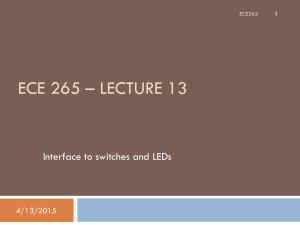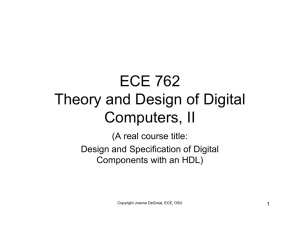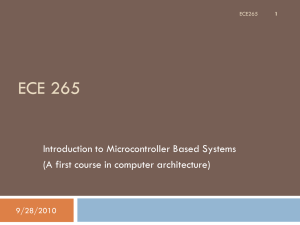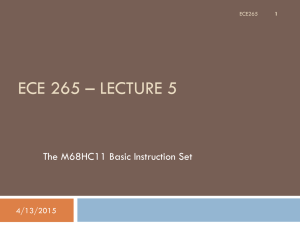Document 9389110
advertisement
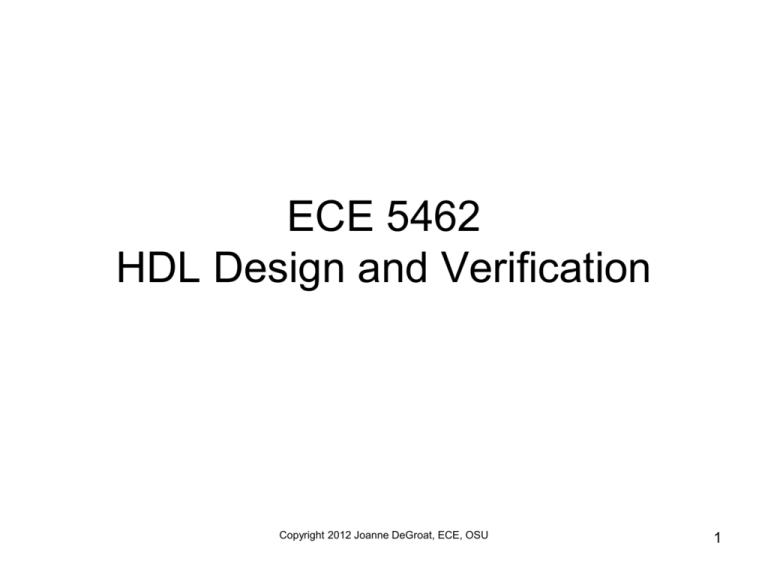
ECE 5462 HDL Design and Verification Copyright 2012 Joanne DeGroat, ECE, OSU 1 Lecture Overview • Course Intro/ Syllabus/ Grading Policy • General Intro to Digital Design • Backgound Copyright 2012 Joanne DeGroat, ECE, OSU 2 Syllabus • The topics list is a guide. Not a class by class syllabus. • Note course objective. • Note grading policy. • There are many, many books on HDLs and a lot on VHDL. Most are not texts; these books are more for reference and often assume you know the language. • There are also several books on verification. No verification text is required. Material will be provided. • Note general policies on syllabus. Copyright 2012 Joanne DeGroat, ECE, OSU 3 Intro • What is a digital system? – Digital (Webster) – System Copyright 2012 Joanne DeGroat, ECE, OSU 4 Intro • What is a digital system? • Digital (Webster) – Of or relating to the technology of computers and data communications wherein all information is encoded as bits of 1s and 0s that represent on or off states. Contrast with analog. Digital implies discrete states. • System – A composite of equipment, skills, techniques, and information capable of performing and/or supporting an operational role in attaining specified management objectives. A complete system includes related facilities, equipment, material, services, personnel, and information required for its operation to the degree that it can be considered a self-sufficient unit in its intended operational and/or support environment. Copyright 2012 Joanne DeGroat, ECE, OSU 5 Graphical Perspective Vectors of binary information Input Data Digital System Control Output Response • A Digital System may be an Application Specific IC (ASIC) or a general purpose computer. • • “Computers are the most important type of digital system.” “Virtually every aspect of digital system design is encountered in computer design.” (Hill and Peterson, “Digital Logic and Microprocessors”) Copyright 2012 Joanne DeGroat, ECE, OSU 6 Digital System Design Process • “Design is a series of transformations.” At each step decisions are made that bind the design, moving it toward an implementation. Design begins at a high level of abstraction and moves to a very detailed level of abstraction. (DeGroat 2005) Idea Possible Implementations Copyright 2012 Joanne DeGroat, ECE, OSU 7 Digital System Design Process • “Design is a series of transformations.” At each step decisions are made that bind the design, moving it toward an implementation. Design begins at a high level of abstraction and moves to a very detailed level of abstraction suitable for implementation. Idea Design Decisions Possible Implementations Copyright 2012 Joanne DeGroat, ECE, OSU 8 Example • Addition of 2 numbers to produce a sum A B + Sum • Design Decisions – – – – – – 2 input vectors Addition operation Single output vector A & B format - ?? – Binary numbers, 16 bits each, unsigned Architecture - ?? – ripple adder, carry lookahead Implementation technology – CMOS, Bipolar, ECL, … • Design Decisions are significantly impacted by the specifications Copyright 2012 Joanne DeGroat, ECE, OSU 9 HDL Design Process • Start with design idea • Do a behavioral design for reference • RTL level design – Design data path – Design control path • Use a synthesis tool to produce a gate netlist • Physical Design – place gates and wire so IC can be fabricated • Production Copyright 2012 Joanne DeGroat, ECE, OSU 10 An example • From ASiC Technology & News – “Why ASICs fail in the system.” – Listen to story about a design that …. • Key points from story. – “Designers knew design was right” – “found a functional error” – Re-fab and still Chips exploded. – Months passed slowly. Copyright 2012 Joanne DeGroat, ECE, OSU 11 Story line • A narration by the CEO – Design was completed – HDL written, chip design generated, design sent to fab – First chip came back and sent to test. – When tested – the chip package blew the top off. – Why, oh, why? – Design was checked for power-ground short – nope. – More and more checks done. Nothing significant found. – Did find a few errors and re-fabbed the chip. – Chips still exploded!!!! – Another investigation. – Now the time passed very, very slowly. – Finally found out that extra metal was added by foundry to enable even metal deposition. Added metal was not grounded!!! Copyright 2012 Joanne DeGroat, ECE, OSU 12 HDL motivations • HDL used to describe hardware for purpose of: – – – – – Simulation Documentation Modeling Testing Design • HDLs provide a convenient and compact format for the hierarchical representation of function and wiring details of digital systems. Copyright 2012 Joanne DeGroat, ECE, OSU 13 PAST HDLs • ISPS – Instruction Set Processor Specification – Language for describing the behavior of digital systems – Developed at CMU – Based on ISP notation Copyright 2012 Joanne DeGroat, ECE, OSU 14 PAST HDLs • AHPL – A Hardware Programming Language – Designed for representation in an academic environment – Developed at the University of Arizona. Copyright 2012 Joanne DeGroat, ECE, OSU 15 Other HDLs • Genrad Hardware Description Language – Describes hardware as a netlist of components. – Developed by Genrad Corporation, UK Copyright 2012 Joanne DeGroat, ECE, OSU 16 Other HDLs • CDL – Computer Design Language – A dataflow language – no hierarchy • CONLAN – Consensus Language – Attempt to establish a standard language. Family of languages for describing hardware at various levels of abstraction. • IDL – Interactive Design Language – Internal IBM – Supports Hierarchy – Originally designed for generation of PLAs, then extended • TEGAS – Texas Instruments Hardware Description Language – Internal TI – Multilevel language for design and description – hierarchical Copyright 2012 Joanne DeGroat, ECE, OSU 17 Other HDLs (cont) • ZEUS – GE language – hierarchical – functional descriptions – structural descriptions – No provision for gate delay specification or timing constraints – Does not support asynchronous designs. • Verilog – Hierarchical – Developed by Cadence Design Systems – Procedural descriptions for behavior – Built in features for timing and a fixed logic value system. Now also a standard. Used by ~60% of market. • UDL1 – Standard language that was developed in Japan – hierarchical – 1 to 1 mapping of language constructs to hardware structures – Designed for synthesis • System C – NEW – now also a standard and supported by tools – had penetrated to about 10% to 15 % of the market. Copyright 2012 Joanne DeGroat, ECE, OSU 18 VHDL • • • • • VHDL – VHSIC Hardware Description Language A standard language – the first. Development began in 1980. Language Requirements set in 1981. 1st Version – Version 7.2 with prototype simulation tools – 1985-1987 • 1st Standard – IEEE Standard 1076-1987 approved in 1987. • New version in 1993. Also versions in 1997, 2000, 2002, and a new version was approved in September 2008. Work on a new version is progressing – language will have some new features. Copyright 2012 Joanne DeGroat, ECE, OSU 19 VHDL features • Procedural Features – Would make a very good concurrent programming language. Up until now file I/O support was poor. • Dataflow design • Structural – Hierarchy • Self defined Value System and capability to design your own if you would need to. – A valuable feature of the language – Some recent work created to ability to do fault simulation in VHDL through creation of a custom value system package. • Semantics and Paradigm formally defined in LRM Copyright 2012 Joanne DeGroat, ECE, OSU 20 In Summary • There is no way we would have systems of today’s complexity without the development and evolution of HDLs. • Has allowed for design methodology change and refinement as new capabilities such a synthesis became available. • HDLs are living languages. – Evolution shown in 2008 standard – 140% increase. • Today’s systems are just too complex to stay with the design methodologies of the 1980s and even to early 1990s. – Consider the time to design a modern processor! Copyright 2012 Joanne DeGroat, ECE, OSU 21 The Future ???? Copyright 2012 Joanne DeGroat, ECE, OSU 22 A web search in 2012 • A new evolution from the 4004 in 1971 (108kHz,2300 transistors,10u) to the Dual core Xeon (>3GHz,820M transistors, 45nm). Copyright 2012 Joanne DeGroat, ECE, OSU 23 A web seach Aug 25, 2015 • From Wikipedia – – – – – – – – – – 1971 TMS 1000 – 8000 transistors – 8um 1971 Intel 4004 – 2300 transistors – 10 um 1972 Intel 8008 – 3500 transistors 1979 Motorola 68000 – 68,000 transistors 1993 Pentium – 3.1 M transistors - .8um 2000 Pentium 4 – 55 M 2006 Pentium 4 Cedar Mill – 184 M - 65nm 2008 Core i7 – 731 M - 45nm 2010 Quad Core Itanium – 2 B 2015 IBM z13 Storage Controller – 7.1 B 22nm Copyright 2012 Joanne DeGroat, ECE, OSU 24
